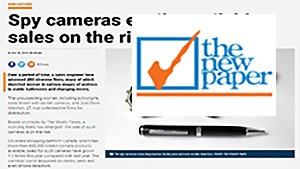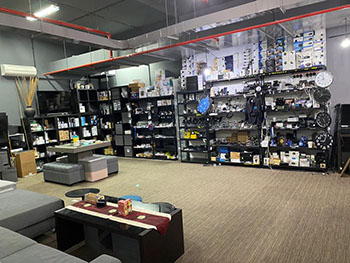Body-Worn Camera
Standard Operating Procedure
Document Control Sheet
Document Properties
Title: Body-Worn Video Camera Standard Operating Procedure
Subject: Use of Body-Worn Video Cameras by NSW Police
Security Classification: UNCLASSIFIED
Publication date: XX/XX/XXX
Current version number: Final Version X.X
Review date: 1 July 2019
Copyright statement: Copyright of this document is vested in the XXXXX © XXXX
Modification History
| Version # | Version approval date | Authorisation | TRIM / Summary of changes |
| 1.6 | 25 August 2017 | XXXXXXXX | Draft SOPs |
| 2.2 | XX XXX XXX | CET | Final Version |
1. Introduction
1.1 Purpose
The purpose of this policy is to establish guidelines for the use, management, storage and retrieval of recordings from the department’s body worn camera (BWC) system. BWC’s will be used to support the mission of the department and assist department officer in the performance of their duties by providing an accurate and unbiased recording of interactions between Officer and the public.
This policy applies to all members assigned a BWC, and any members, investigative personnel, and support staff responsible for preparing cases for criminal prosecution and the release of public records.
BWC support operational policing activities. They will be used where officer believe it is appropriate to record the events taking place or the environment they are operating in. The cameras will support the officer investigations by recording visual and audio evidence of an incident or crime.
The use of BWC will be incident specific, and the cameras will be worn on a officer’s uniform/clothes in an overt manner. Members of the public will be advised they are being recorded if it is practicable to do so before or at the time of activating the recording. If it is not practicable to do so before or at the that time, as soon as is reasonably practicable after activating the recording.
The footage can only be used under certain circumstances as prescribed in the Act or under a regulation made under the Act. If officer fail to record something of relevance, they may be asked to explain their decision to a supervisor.
BWC content will be securely stored, archived and disposed.
Five Guiding Principles provide the basis for proper use of BWC by officers.
1. Body-Worn Camera equipment will be used by Officer in the lawful execution of their duties. Officer will use their judgement when deciding to use it and its use will be obvious and overt.
2. Body-Worn Camera will be used by officer to record events, incidents and evidence. There will be some instances where Body-Worn Camera should not be used and some occasions when its use may not be appropriate.
3. Body-Worn Camera supports conventional forms of evidence gathering; it does not replace them.
4. Body-Worn Camera recordings will be securely processed and managed in accordance with relevant legislation, policy and procedures.
5. Officer will provide general information to the public on the use of Body-Worn Camera by them.
2. Body-Worn Camera – Operational Guidelines
2.1 Pre-Shift Inspection
Prior to each shift, officers assigned a BWC will ensure the unit is adequately charged. Further, officers will inspect their camera to ensure there is no visible damage and the device is in good working order. Any visible damage or concerns about the functionality of the equipment will be brought to the attention of the member’s immediate supervisor as soon as it is practical to do so.
2.2 Conditions of Use
Each BWC system will be used to document various events that occur during the duty shift of the assigned officer. Upon completion of the assigned officer’s shift, all captured data will be preserved in a secure recording storage location. Upon captured, these recordings are protected with password and cannot be altered.
BWC technology facilitates the department’s objectives to collect evidence for prosecutions, ensure both officer and citizen accountability, facilitate administrative inspection functions, and provide a valuable training aid by allowing for the evaluation of officer and citizen behavior.
A BWC can be used by a officer wearing uniform, but any use must be overt and in the lawful execution of duty. Overt use refers to the use of a BWC device in a way that it can be seen and identified as a video and audio recording device. The device is to be worn so that it is observable and not hidden, concealed or secreted. Officers will, when practicable, announce to persons they are speaking with that their conversation is being recorded by the BWC being worn by the officer.
Any officer in plain clothes must not use the BWC. All officers wearing their uniform, whilst engaged in duties of operational response, should wear as part of their uniform a BWC for use in accordance with these SOPs. Officer engaged in proactive and/or investigative duties should also take and use BWC in support of their policing activities.
2.3 Officer Use of Body Worn Camera – General Information
Officer will not be required to record their entire shift or every interaction that occurs whilst they are on duty. BWC recordings should be incident-specific (whether or not the recording is ultimately required for use as evidence). Officers with a BWC shall make every effort to activate their BWC for all investigative or enforcement contacts including, but not limited to:
1. Vehicle stops
2. Impaired driver investigations
3. Field interviews and pedestrian stops
4. Transporting citizens or prisoners
5. Searches of persons or property
6. Dispatched calls for service
7. Crime scenes
8. Crash scenes (may be turned off if member is waiting on a tow truck and no additional enforcement activity is likely)
9. Suspect/witness statements and interviews
10. Vehicle and foot pursuits
11. Emergency response to critical incidents
Once a BWC is recording, members must continue to record until either the completion of the event or until they leave the scene and their involvement in the event ceases.
While not required by policy or state law, officers assigned a BWC may find it valuable to inform other parties that they are being recorded. This has proven to be influential in garnering cooperation of subjects and has been shown to reduce incidents of use of force.
2.4 Prohibited Recordings:
In keeping with the department’s core values of respect and integrity, officers assigned a BWC will adhere to the following guidelines:
1. BWC’s will not be activated in a place where a reasonable expectation of privacy exists, such as dressing rooms, locker rooms and restrooms. Any purposeful or accidental recordings made under these circumstances may be deleted prior to the standard 7 day retention period by officer’s supervisor.
2. BWC’s shall not be used to record a body cavity search, which are only allowed to occur in a hospital or medical setting. BWC’s will be used to record searches done by officers in the field (e.g., pat-downs, vehicle searches).
3. BWC’s will not be intentionally activated to record conversations of fellow officers without their knowledge during routine and non-enforcement activities. This includes while a officer is on a rest break, while report writing, attending roll calls, general discussions with other officers, discussing a case with another officer, or performing other administrative functions.
4. BWC’s will not be utilized to surreptitiously record conversations of the public and/or other officers of the department.
5. Members utilizing a BWC will not knowingly record undercover officers or confidential informants.
6. BWC’s will not be utilized to record any off duty or personal activity.
2.5 Objections to Recording
Police may also cease recording if they believe there are compelling reasons for doing so. These reasons should be placed on the video record prior to the recording being stopped.
2.6 Uploading Body Worn Camera Footage
At the end of a shift return the BWC to the docking station where uploading will begin automatically. Footage will remain on the local server until it is ‘tagged’ by the user as content that is
of evidentiary value ie: the footage may be relevant to an investigation, disciplinary procedure, legal claim or complaint. Content not tagged is considered non-evidentiary and will remain unclassified on the local server for a period of one months, when it will be automatically deleted.
BWC footage/content can be tagged under three (3) categories:
1. Evidence
2. WHS (Work, Health & Safety) – only to be used where the content is not already tagged as evidence and it relates to a work, health and safety issue that might be in the interests of the
BWC user
3. Complaint – only to be used where the content is not already tagged as evidence and only where an officer believes that keeping such footage may assist in the investigation of a
possible future complaint.
2.7 Using Body-Worn Video Footage
If an officer’s image has been, or may have been recorded by BWC, and that officer has concerns about their image being released (eg: provided as part of a brief of evidence), they must advise the
OIC of the case if they want their image to be redacted prior to release.
Do not use, communicate or publish BWC content unless it falls within one of the authorised uses identified, such as:
• in criminal court proceedings
• Coronial inquests and inquiries
• where the material has been disclosed in open court or where the material has entered the public domain
• the investigation of offences
• brief/statement preparation, or advice on whether a prosecution should be commenced and for what offence
• investigation of complaints including oversight by the Law Enforcement Conduct Commission
• connected with the training and education of Officer
• connected with the exercise of a law enforcement function by a officer
• investigation of critical incidents
Do not copy, use or disclose BWC material for non-official purposes, such as to show to any unauthorised person or share on social media. In certain circumstances, it may be lawful to release BWC footage to news media with authority.
A complete copy of BWC footage, or an edited version for court, defence and prosecution may be created. Images from the footage can also be captured as photographs for use as evidence and may
require compliance with the Crimes (Forensic Procedures) Act. Copies of BWC footage for production at court can be made in many video formats including DVD. In some cases, custom editing may be required for BWC content.
2.8 Viewing Body-Worn Video Footage – Accused Person/Legal Representative
Where BWC content is to be used to support a charge or legal process, officer may offer the accused, and/or their legal representative, an opportunity to view BWC content. This should be offered before the date of first court mention and/or before entry of a not guilty plea. If the opportunity is accepted, viewing of the BWC footage is to be facilitated under officer supervision.
If an accused or their legal representative requests further viewing of BWC footage, this may also be facilitated.
2.9 Review and Audit
Officer supervisors will have access to BWC footage for auditing of compliance with Body Worn Camera procedures and standards. The BWC application will generate random ‘dip samples’ for checking by officer supervisors on a regular basis or on demand.
2.10 Release of Body-Worn Video Footage
The Officer Supervisor may release BWC images to the public for a number of reasons, including:
• tracing wanted suspects
• locating people who have escaped or absconded from custody
• public safety
2.11 Repair / Replacement
When a BWC is in need of repair or replacement due to damage, the officer assigned the camera must notify their supervisor. The supervisor must investigate, and once confirmed, remove the camera from operation. If a BWC kiosk, docking station or software is not operating as it should, report the issue to a supervisor. The supervisor must investigate and once confirmed, inform vendor. If the entire operating system is not functioning, consider suspending camera use until the malfunction has been repaired and the system returned to operational status. BWC replacement parts and/or systems are available by contacting the BWC vendor via a supervisor.
2.12 Critical Incident Protocol
1. A critical incident for the purpose of this SOP is any police action or activity that directly or indirectly results in great bodily harm or death to a department member and/or a citizen.
2. In the event of a critical incident, members assigned a body worn camera will refrain from viewing the recorded data until the investigative entity responsible for the investigation arrives on scene.
3. If the critical incident is investigated by an outside agency, the outside agency lead investigator shall make the determination if the involved-officer(s) will be permitted to view the recorded data.
4. If the critical incident is investigated by the department, the Chief of Police, or his designee, shall make the determination if the involved-officer(s) will be permitted to view the recorded data.
5. This section does not prohibit members in critical incidents with ongoing exigency from viewing body worn camera recordings that may aid the present investigation (e.g., suspect descriptions, suspect vehicles, direction of travel, etc.).
6. If there are BWC’s in use during a critical incident, a police supervisor assigned to the Investigations and Intelligence Bureau and not involved in the actual critical incident will take physical custody of any BWC’s that may have captured the incident and deliver them to the nearest police district where the same police supervisor will immediately upload them into Evidence.com by placing the camera device into a camera charging/download port.









